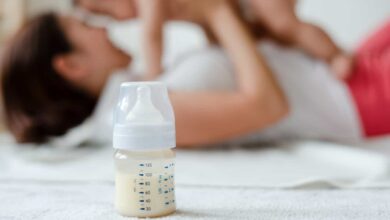Can I Give My Newborn A Pacifier While Breastfeeding

You can introduce a pacifier while breastfeeding to your newborn. Still, waiting until breastfeeding is well-established, usually around 3 to 4 weeks, is often advisable to avoid potential nipple confusion. Ensure the pacifier use doesn’t interfere with breastfeeding success.
Breastfed baby Pacifier at Night
Offering a pacifier to a breastfed baby at night can provide comfort. Still, it’s best to wait until breastfeeding is well-established, typically a few weeks after birth, to avoid nipple confusion. Seek guidance from a healthcare provider or lactation consultant for safe pacifier use.
Benefits of Pacifier while Breastfeeding
1. Soothing and Comfort
A pacifier can help calm and comfort a fussy or colicky breastfeeding baby, promoting better sleep for both baby and mother.
2. Reduced SIDS Risk
Some studies suggest that pacifier use during sleep can lower the risk of sudden infant death syndrome (SIDS).
3. Extended Breastfeeding
Using a pacifier at appropriate times, such as when breastfeeding is established, can help extend breastfeeding duration by preventing the baby from comfort nursing excessively.
4. Pain Relief
Pacifiers can be a source of pain relief for teething babies, which can, in turn, make breastfeeding more comfortable for the mother.
5. Sleep Aid
Using a pacifier at night can help improve sleep patterns by soothing the baby back to sleep without needing to nurse, giving the mother more rest.
When to Introduce pacifier Breastfeeding
Introducing a pacifier for breastfeeding babies is generally recommended when breastfeeding is well-established, usually around 3 to 4 weeks after birth. This helps minimize the risk of nipple confusion and ensures a strong breastfeeding bond.
Is it Okay to Give a Pacifier after feeding
Yes, offering a pacifier to your baby after feeding is generally okay. Pacifiers can provide comfort and soothing if your baby still seeks non-nutritive sucking. Before introducing the pacifier, it’s essential to ensure that your baby has finished feeding and is not hungry. It’s typically recommended to wait until breastfeeding is well-established (usually after a few weeks) to avoid potential nipple confusion.
Best pacifier for Newborn Breastfed baby
The best pacifier for a newborn breastfed baby should ideally meet the following criteria:
- Orthodontic Shape: Look for a pacifier with an orthodontic shape to support proper oral development and minimize the risk of dental issues.
- One-Piece Design: A one-piece pacifier is easier to clean and reduces the risk of choking hazards.
- BPA-Free: Ensure the pacifier is made from safe, BPA-free materials to avoid harmful chemicals.
- Size and Age-Appropriate: Choose a pacifier suitable for newborns with a size appropriate for their age.
- Easy to Clean: Opt for a pacifier that is easy to clean and sterilize, given the importance of hygiene for newborns.
- Good Reviews: Research and read reviews to find a pacifier that other breastfeeding parents have found effective and safe.
How long Should a Baby use a Pacifier in a Day?
The duration and frequency of pacifier use can vary depending on the baby’s age, individual needs, and preferences.
Here are some general guidelines:
- Newborns: In the early weeks, it’s typically best to introduce a pacifier after breastfeeding is well-established, typically around 3 to 4 weeks of age. At this stage, pacifiers can be used sparingly to soothe the baby when needed.
- Infants: As the baby grows, pacifier use can be helpful for soothing, especially at naptime or bedtime. Limiting pacifier use to sleep times or when the baby needs comfort can be beneficial.
- Toddlers: As the baby becomes a toddler, consider gradually reducing pacifier use to prevent dependency. Pediatricians often recommend weaning from the pacifier by age 2 to 4, as extended use can affect dental development.
FAQ’s
Can I give my newborn a pacifier while breastfeeding?
Yes, but it’s advisable to wait until breastfeeding is well-established, typically around 3 to 4 weeks, to minimize nipple confusion.
Will giving a pacifier affect my baby’s latch during breastfeeding?
Introducing a pacifier while breastfeeding is established is less likely to affect your baby’s latch.
How can I safely introduce a pacifier to my newborn while breastfeeding?
Ensure a vigorous breastfeeding routine and monitor for potential issues, consulting with a healthcare provider or lactation consultant for guidance.
Conclusion: Lady Well Care offers personalized fitness, culinary, and nutrition solutions to promote your wellness and happiness throughout pregnancy, breastfeeding, and the postpartum phase.
- Explore our thoughtfully selected articles on the Homepage, intended to assist you in achieving improved health and heightened well-being.



